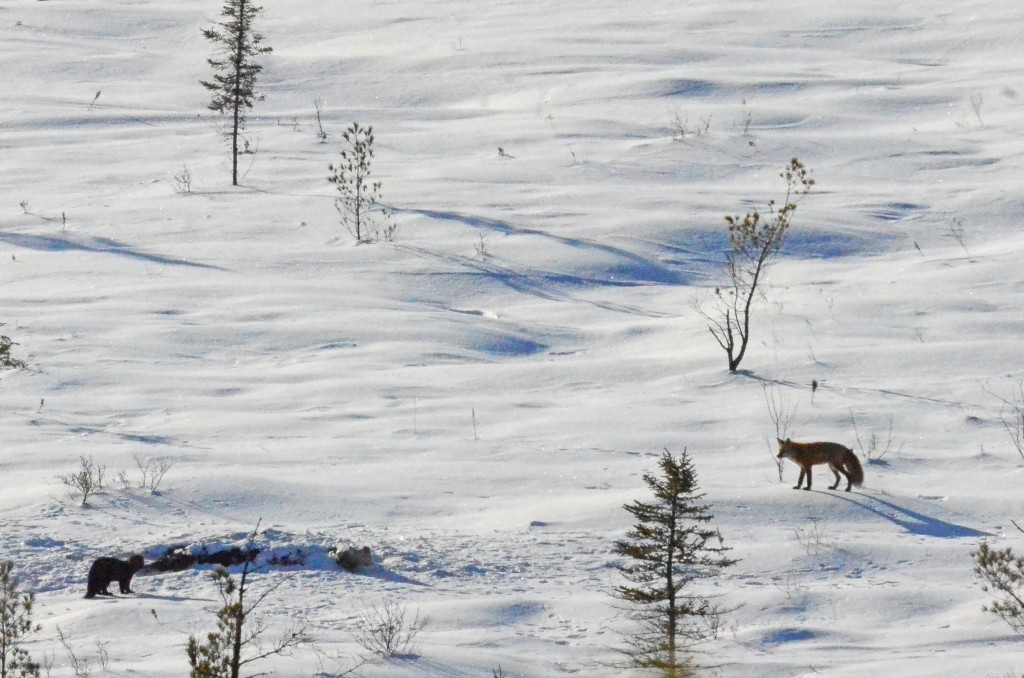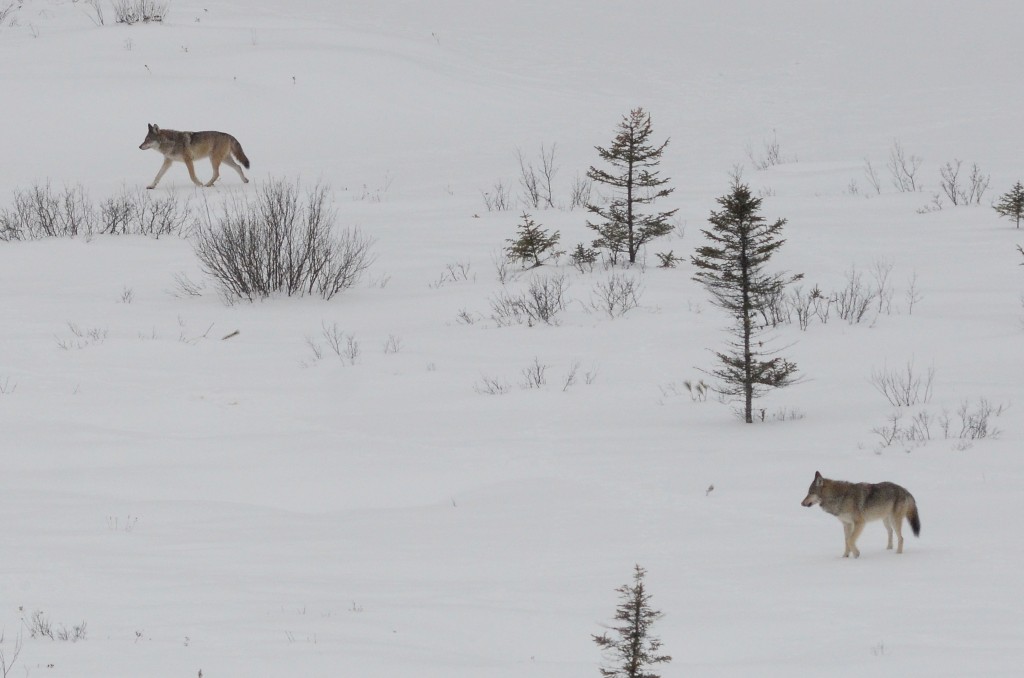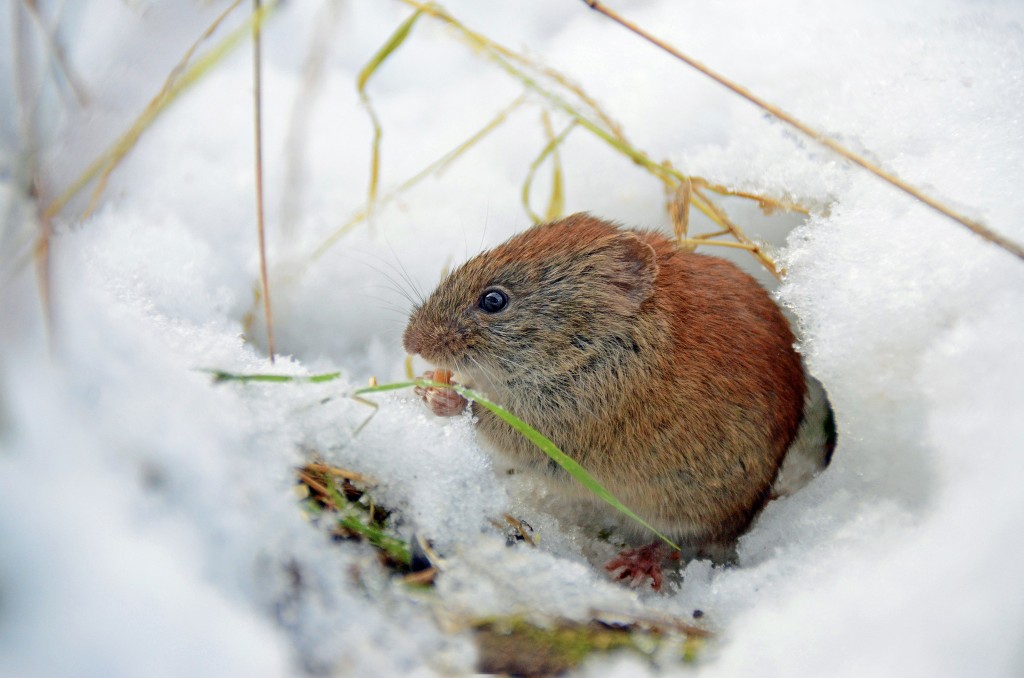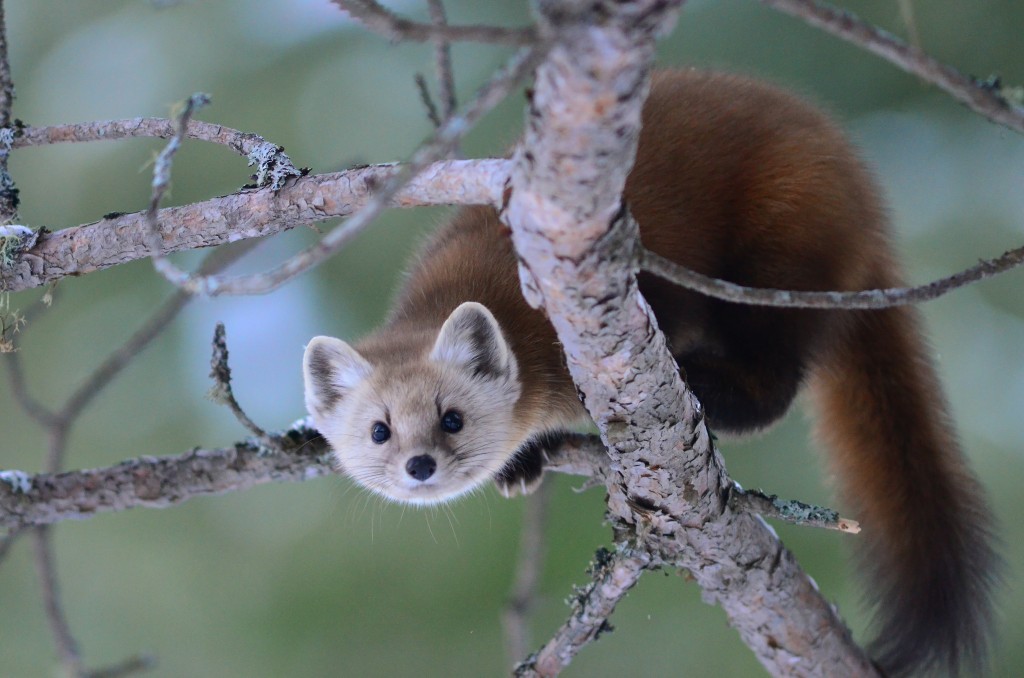Tips for Winter Carcass Watching in Algonquin Park
Hi folks. My name is Lev Frid and I am a naturalist with the Ontario Ministry of Natural Resources in Algonquin Provincial Park. I have been a long-time lurker of this excellent site and it has helped me find mammals in many of my travels. I figured I would return the favour and post some of my own trip reports.
As you all know, Algonquin Park is an excellent destination in Ontario, Canada for viewing a variety of mammal species. This is never truer when a carcass of a moose or deer killed by vehicle collision is placed off the viewing deck of the visitor centre. I have had the pleasure of observing several of these carcasses, and thought I would share how a normal “timeline” plays out, so that during the next time it happens, one could try to plan a trip accordingly to view some of the desired mammals. I will use the most current carcass as an example of a typical timeline, provide tips for viewing specific animals coming to the carcass, and at the end provide additional tips for winter mammal viewing in Algonquin Park and nearby areas.
January 5, 2017
The carcass of a moose killed on Hw 60 (the main road that leads through the southern portion of the park) was placed in the valley below the Visitor Centre Viewing Deck, approximately 500 metres away from the viewing location. A scope is highly recommended for viewing. The park provides two scopes, but sometimes there are crowds and you want to enjoy the animals at your leisure.
January 8
A Red Fox has visited the carcass as the first confirmed mammal. This particular animal was likely part of a pair that has been habituated to people at a trail close to the site. I would say this is quicker than average for an animal discovering one of these carcasses. It usually takes anywhere from several days to three or four weeks (such as in 2016, when it was extremely cold) for “first contact”. I’m not sure why this is, but one of the reasons is likely that the scent of humans lingers.
In any regard – it is wise for folks that are traveling not to book your travel as soon as a carcass is laid out. It would be more appropriate to wait for an update on the park’s social media or website that the carcass has been discovered, as after that initial event is when the action really intensifies. The park has a live webcam that is usually a panoramic view of the deck, but it is pointed at the carcass when there is one. This can be a good thing to watch for as well.
January 9-13
The Red Fox continues visiting the carcass but no sign of other species.
January 14
The Red Fox continues, but is joined at about noon (12:00 PM) by a large male Fisher. This is about the standard amount of time that it takes for mammals to come to the carcass after it has been placed. I believe the Red Fox arriving so early was due to the fact it was habituated.
When Fisher discover the carcass, there seems to be a relatively predictable pattern to their initial visits. It seems that on the first day or two, they are present at the carcass for nearly the entire day – so if planning to see a Fisher in Algonquin, perhaps the best “plan of attack” would be to arrive as soon as you hear the animal has found the carcass. After the first couple of days, the animals still visit but sporadically and unpredictably. Indeed, it did not take long for the first Fisher on this day to be joined by a second, smaller animal. Both were seen almost continuously on January 14 from the initial sighting at 12:00 PM up until 5:00 PM when the Visitor Centre closed to the public.
January 15
I was visiting family in Toronto this weekend with my girlfriend Amanda Guercio. We learned that the Fisher had started to come to the carcass. I live just outside the park in Huntsville (a good base of operations for those visiting the park) and we quickly finished up our business in the city and drove north as fast as possible!
Amanda was watching the Fisher at the carcass on the live webcam as we drove up and I was hoping that, as in the past, the animal(s) would be there all day – and thankfully I was right! Both Fisher were seen at the carcass almost continuously from 8:00 AM when the centre opened to 5:00 PM when it closed. The Red Fox visited briefly in between the visits from the Fishers, but this was only usually a small time interval and the Fishers drove it off when they came back.
We got there at about 3:00 PM and were treated to the sight of the massive male Fisher feeding at the carcass for over 40 minutes, scent-marking, rolling about in the snow, and chasing the Red Fox. It was an incredible sight and even after nine years of working in this park I was overjoyed at this amazing opportunity.

Red Fox waits for the Fisher to finish his meal.
We then headed to Mew Lake Campground, where we saw three American Martens at extremely close range, scavenging from the garbage containers. We returned to the Visitor Centre just as it was closing up and took in the sight of two Fisher – the large male and a smaller animal – chasing each other near the carcass, as another American Marten was feeding on the suet feeder as the sun was setting. A great day!
A visitor had photographed a single Eastern Wolf from the deck on Fork Lake (1 km from the deck, about 600 m from the carcass) on this day (Jan 15). It did not approach the carcass.
January 16 – 17
The Red Fox and one or both Fisher were seen at the carcass during various times of day, on both days. The best time for the Fisher seemed to be the early morning and mid-afternoon after about 2:00 PM.
There was much hope on these days that the Eastern Wolf seen on the ice of Fork Lake, 600 metres from the carcass on January 15 would return, but there were no sightings on these two days.
January 18
In the early morning, as viewed on the live camera, two Eastern Wolves fed on the carcass until a little bit after 8:00 AM. They seemed very wary and left the carcass before it got very light. The centre was not yet open to the public.
The Red Fox and Fisher continued at various times, especially after 2:00 PM, but less reliably than before.
The Eastern Wolves made another appearance at the carcass at about 4:30 PM (after the centre had closed!) and fed until it got too dark to see. Unlike the Fisher, when wolves visit the carcass they have an unpredictable schedule, but dawn and dusk seem to be the best times. It is a good idea when targeting Eastern Wolves to wait until the first animals have been spotted feeding on the carcass. It usually takes the wolves the longest of any of the scavengers to find the carcass – likely because they are more wary of people.
January 19
The Eastern Wolves were not present at the carcass in the morning. The Red Fox continued throughout the day. I do not think anyone saw a Fisher on this day, but there were few people looking. In any case, by this time they were becoming quite sporadic.
At 1:00 PM, a visitor photographed two Eastern Wolves once again on the ice of Fork Lake, from the deck. They did not come to the carcass.
At 5:35, in the last remaining minutes of daylight, a single Eastern Wolf showed up at the carcass to feed.
The two wolves that were being observed on these past two days were very skittish to come feed. In the past, often wolves would feed very aggressively during the day. Chief Park Naturalist Rick Stronks suggested that these two may have been a new pair that did not yet have a pack, and may have been intruding on another territory.
January 20
Amanda and I arrived in the park in the early morning, hoping that the Eastern Wolf would still be at the carcass. It was not. Kevin Clute who was working here early observed a Fisher at the suet feeder at first light.
It was surprisingly quiet at the carcass, and we discovered that a photographer had walked down into the valley and attempted to set up a crude blind. Of course, this put off any animal from visiting and we were disappointed, so we left.
We came back at around 11:30 AM, having just missed a Fisher that was visiting for a few minutes. The photographer had packed up and left. After waiting for about a half-hour, I spotted an Eastern Wolf slowly making its way towards the carcass. We observed it for a good long time and then saw another Eastern Wolf join it. They approached the carcass very cautiously, taking time to scent-mark frequently. Then something scared them and they took off running.

Eastern Wolves approaching the carcass.
At 4:30 PM, after the centre had closed and as it was getting dark, an Eastern Wolf arrived and fed at the carcass until dark.
January 21
In the early morning, two Eastern Wolves were feeding on the carcass. At least one animal was different from the two observed prior, as it had a radio collar.
These animals fed fearlessly and aggressively, much to the delight of the Saturday crowd that was forming on the Visitor Centre viewing deck. As the crowd was increasing and inevitably becoming louder, the animals slowly walked off, one carrying a large leg bone of the moose away. They had fed from the opening hours of the Visitor Centre at 8 AM until 11 AM – enabling dozens of people and possibly hundreds watching on the cam to observe wild Eastern Wolves in Algonquin Park – but not the group I was guiding – we missed them by about a half hour!
The wolves did not return in the evening, perhaps because of the large volume of people. A Fisher was sighted sporadically.
January 22
Not much was left of the carcass. A Fisher visited the carcass briefly at about 8:00 AM.
I arrived with my group at around noon. I spotted two Eastern Wolves making their way across Fork Lake. They took their time and allowed some nice views before disappearing into the woods. The group was happy. The deck now had a substantial crowd.
About 45 minutes later, an Eastern Wolf wearing a collar was spotted, and it was approaching the carcass slowly. There were a lot of people on the deck at the time, and even though we tried our best to be quiet, the overwhelming motion, noise and probably smell dissuaded the animal from coming to feed and it turned around and left.
The Red Fox was making sporadic visits throughout the day.
January 23
There was not much left of the carcass. The live cam was returned to its normal panoramic mode. I have not heard of any sightings since then, but the animals may have visited sporadically.
A couple of interesting notes:
- This carcass lasted longer than usual. This was likely because of the small number of Eastern Wolves visiting it sporadically. Some carcasses, when discovered by wolves, are wolfed down very quickly as multiple animals visit for prolonged periods. For this reason, if targeting wolves, it is important to visit quickly after the first ones come to the carcass as they eat it up rapidly.
- Adding to the above point, only a couple of wolves ever visited the carcass at one time. In previous cases, up to seven wolves were seen feeding at one time.
- Volume of people has an impact on the presence of animals (obviously) so if planning a trip, it may be better to avoid weekends, though sometimes this is not possible.
- The carcass was visited by at least two, possibly three different Fisher.
Other Winter Mammals to see in Algonquin Park
American Red Squirrel – These are the standard winter squirrels in the park and are widespread and easy to find.
Eastern Gray Squirrel – The foreign traveller may be interested in observing the black morph of this beast. They are not found in Algonquin Park but are pretty easy to observe in Huntsville. Avery Beach Park just west of downtown is a good bet.
Northern/Southern Flying Squirrel – Both species are present in the park for those wishing to seek them out at night. Identification may be difficult as integrades occur in the park.
Southern Red-backed Vole – These attractive voles are sometimes seen visiting the birdseed below the deck. Watch for them scampering on the rocks.

Snowshoe Hare – These are, rather unsurprisingly, difficult to find during the day. Best chances are driving the road at night.
Moose – These are not very reliable anywhere in the winter but when you do find them, they are beside or on the highway, getting salt.
American Marten – Anywhere there are bird feeders or garbage containers is a good bet. Mew Lake Campground is the best spot, but Spruce Bog Boardwalk, Opeongo Road and the Visitor Centre also have opportunities.

American Mink – Could be encountered anywhere there is water in winter – the Opeongo Road is a good bet.
Northern River Otter – Eucalia lake, just west of the Lookout Trail, and Costello Creek along the Opeongo Road are good places to try. At the end of Opeongo Road, for those who like to hike, there is a very good chance of seeing these.
4 Comments
-
William Vanderpoel
I just came across this excellent post and great pictures and as I am trying to plan a winter trip, this got me very interested in Algonquin Park! I really would like to see a fisher and an eastern wolf. If you hear of another carcass being discovered and placed for observation I would definitely appreciate a note! Thank you very much!
Bill Vanderpoel
-
RICHARD WEBB
Bill, if you keep an eye on the following link to the Algonquin birding report which is updated every Friday it gives details of good mammal reports as well. There are for example two American Martens being seen regularly at the moment. Fortunately most birders don’t avert their eyes from mammals.
http://www.algonquinpark.on.ca/news/algonquin_park_birding_report.php
-
Jon Hall
Bill, you can also follow The Friends of Algonquin on facebook. https://www.facebook.com/TheFriendsofAlgonquinPark/?ref=br_rs
If they place a carcass in front of the visitor centre they will generally announce it and have a live webcam feed… unfortunately the presence of a a carcass seems to depend on whether any animal gets killed on the road so its hard to predict though the good news is – if you are planning a trip – there is usually quite a long run up time between when the carcass is placed and when the animals start feeding.
Leave a Reply
You must be logged in to post a comment.


Nathan
This is a nice article about the tips for watching the winter carcasses. Algonquin Park is a very good destination situated in Ontario, Canada if one enjoys viewing various mammal species. After reading the tips in this article you will be able to arrange for a trip properly to view various desired mammals.